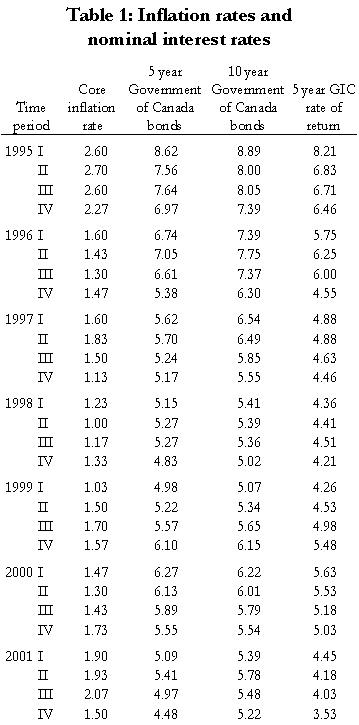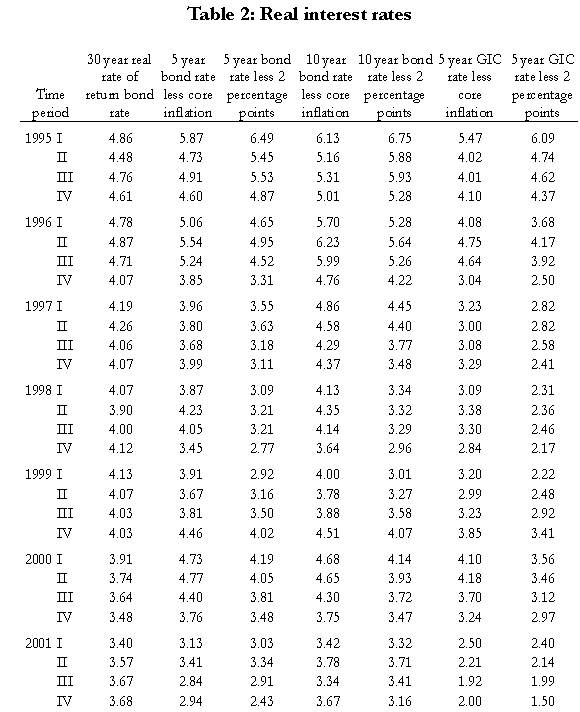This article was originally published in the Winter 2001/02 issue of the Expert Witness.
In the Autumn 2000 issue of this newsletter, we conducted an extensive review of the various methods of measuring the real rate of interest, or discount rate, and presented evidence concerning the movement of those measures over the period 1995-2000.
At that time, we concluded that our best estimate of the long-run discount rate was 4.0 percent. But we added the caveat that, as interest rates in 2000 had deviated significantly from the average of the preceding years, it would be important to maintain a close watch on those rates – to determine whether 2000 was an aberration or whether it represented the beginning of a new trend.
In particular, we concluded that article with the statement:
If bond rates do not rise relative to the rate of inflation in the near future, we will be revising our real rate of interest forecast downward.
The purpose of this article will be to provide five additional quarters (15 months) of data to determine whether such a revision is appropriate.
Revised data
Tables 1 and 2 provide updates of the information contained in Tables 1 and 2 of the Autumn 2000 article. Four changes have been made to the latter tables. First, we have added data for the fourth quarter of 2000 and for all four quarters of 2001. Second, in some cases, the relevant statistical authorities have revised their estimates of the figures we reported previously. In those cases, we have provided the revised figures.
Third, we have added information concerning interest rates on five-year Government of Canada bonds. Finally, in the interest of space, we have omitted the estimates of the real rate of interest that relied on information concerning the “standard” inflation rate.

Table 1 reports the “raw” data from which some of the real interest rate figures in Table 2 have been calculated. The first column reports the “core rate of inflation” – a measure of the rate of inflation that removes the effects of change in those components of the price index that often move erratically – such as food, energy, and taxes. It is often argued that this measure offers a more reliable predictor of future changes in prices than does the “standard” measure of price inflation.
The next three columns in Table 1 report the rates of return on Government of Canada 5-year and 10-year bonds and on 5-year Guaranteed Investment Certificates (GICs). The former represent the minimum rates of return that investors can expect on safe investments. The rate of return on GICs, on the other hand, represents the interest rate available on a mixed, low-risk portfolio of stocks and bonds.
Table 2 reports seven measures of the real rate of interest – that is, the rate of interest net of the expected rate of inflation. The first of these is the market-determined rate of return on “real rate of return bonds” – bonds whose value is denominated in terms of the real rate of interest. These bonds are of particular importance because they are purchased by sophisticated investors and because they tend to be held for long periods of time.
The second, fourth, and sixth columns report the 5- and 10-year government bond interest rates and 5-year GIC rates net of the core inflation measure.
Finally, columns three, five, and seven report the government bond and GIC rates net of the Bank of Canada’s target rate of inflation of 2 percent. As the Bank has managed to keep the core rate of inflation within a small band around this target for the last six years, it is widely believed that 2 percent is the rate that is expected by most investors. That is, investors are believed to act as if the real rate of interest is the observed, nominal rate less 2 percent.

Interpretation of the data
The data in Table 2 indicate that real rates of interest are lowest on the shortest-term investments, GICs and 5-year bonds, and highest on the longest-term investments, 10-year bonds and real rate of interest bonds. This suggests to us that investors believe that the current slowdown in the economy, which has induced central banks to lower interest rates very significantly, may continue for two or three years but will not continue in the long term.
For this reason, we believe that it would be appropriate to adopt a two part forecast of real interest rates. Based primarily on the observed rate on 5-year Government of Canada bonds, we propose to use a rate of 2.50 percent for the first five years of all calculations. Based primarily on the observed rate on 10-year Government of Canada bonds, we propose to use a rate of 3.50 percent for all subsequent years. Note that the latter rate is close to the average real rate of return on GICs over the period 1964 to 1998, (3.58 percent), reported in Bruce, Assessment of Personal Injury Damages, Third Edition, at page 231.
Once again, however, in recognition of the uncertainty facing our economy, we will revisit this question at the end of this year.
![]()